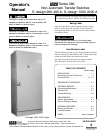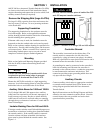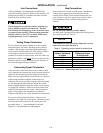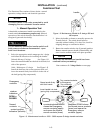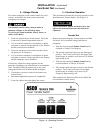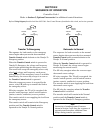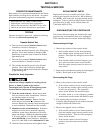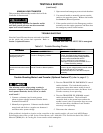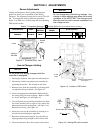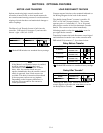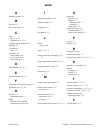
SECTION 1 INSTALLATION
1 --- 1
ASCO 386 Non–Automatic Transfer Switches (N–ATSs)
are factory wired and tested. Field installation simply
requires mounting and connection of service cables, and
auxiliary control circuits (if required).
Remove the Shipping Skid (large N–ATSs)
For large N–ATSs, open the front door and remove the
four lag screws (2 in front, 2 in rear) securing enclosure
to the wood skid.
Supporting Foundation
The supporting foundation for the enclosure must be
level and straight. Refer to the applicable enclosure
outline drawing included with the switch for all mounting
details including door opening space.
If bottom cable entry is used, the foundation must be
prepared so that the conduit stubs are located correctly.
Refer to the enclosure outline drawing for specified area
and location. Provide cable bending space and clearance
to live metal parts. When a concrete floor is poured, use
interlocking conduit spacer caps or a wood or metal
template to maintain proper conduit alignment.
Mounting
Refer to the Outline and Mounting Diagram provided
with the N–ATS; it shows all mounting details and
instructions.
NOTICE
Protect the non–automatic transfer switch from
construction grit and metal chips to prevent
malfunction or shortened life of the N–ATS.
Mount the ASCO 386 vertically to a rigid supporting
structure. Level all mounting points by using flat washers
behind the holes to avoid distortion of the switch.
Auxiliary Cable Boxes for 1000 and 1200 A
For G–design 1000 and 1200 ampere sizes, auxiliary
cable boxes are required for all (normal, emergency, &
load) bottom or top entry. Be sure to install auxiliary
cable boxes if both service and load cables are entering
through the top or bottom of enclosure. Consult ASCO
Power Technologies.
Insulator Backing Piece for 260 and 400 A
E–design transfer switches rated 260 and 400 ampere are
mounted on an insulator backing piece (installed behind
the transfer switch). If the transfer switch is removed
from the cabinet and then reinstalled, this insulator
piece must be placed behind the transfer switch. See
Figure 1-1.
Be sure that the insulator piece is behind the 260
and 400 ampere transfer switches.
insulator
backing
piece
Figure 1-1. Insulator for E–design 260 an d 400 ampere
Controller Ground
The controller is mounted on the cabinet door. The
transfer switch is connected to the left side of the
controller by a plug–in harness (two plugs). An add-on
DIN rail is provided for some optional accessories and is
mounted below the controller on the door.
A grounding wire must be connected to the controller’s
lower left mounting stud. Because the controller is
mounted on the enclosure door, a conductive strap must
be used between the enclosure and the door. This
connection provides proper grounding which does not
rely upon the door hinges.
Auxiliary Circuits
Connect auxiliary circuit wires to appropriate terminals
on transfer switch terminal block TB as shown on the
wiring diagram provided with t his Non–Automatic
Transfe r Switch.
Read all instructions on the Wiring Diagram and labels
affixed to the non–automatic transfer switch. Note the
control features that are provided and review their
operation before proceeding.



